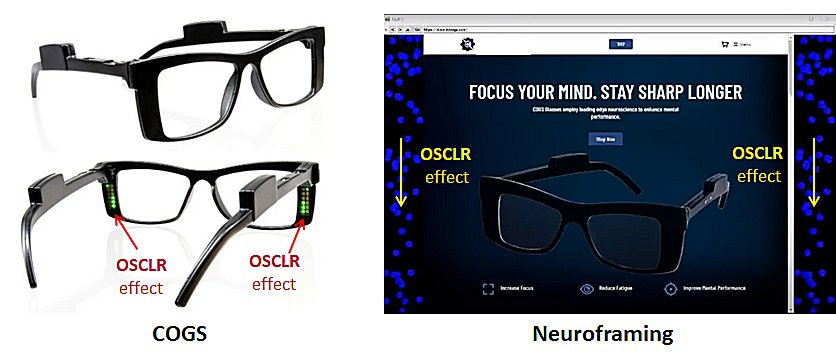Optically Stimulated Cognitive Load Regulation (OSCLR)
The Technical Innovation
In a series of dissertation pilot studies to measure the effects of movement in the peripheral field of view, the founder and owner of Bevilacqua Research Corporation (BRC) discovered a way to regulate cognitive load in real time by redirecting the brain’s “fight-or-flight” processing resources to focus on the primary task.
Since that time, BRC has been working to enhance, expand, and optimize the cognitive capabilities of individuals and small teams in a variety of training environments. BRC has developed a technology called Optically-Stimulated Cognitive Load Regulation, or OSCLR. taking advantage of the brain’s reaction to non-threatening (e.g. non-biological) motion in the peripheral vision. Regulating cognitive load in this manner enhances one’s ability to learn faster and with greater retention, enhancing focus, and reducing both mental and physical fatigue during strenuous or tedious task. Figure 1 shows two ways that the OSCLR effect can be presented to the user, the first is by wearing glasses (called COGS)that project the non-biologic motion in the peripheral vision using LED’s; the second is by applying the effect at the left and right edges of a display (called Neuroframing).

The Technical Objectives and Challenges
We are conducting research in several of these product application areas, however the suite of tests necessary to validate the results and to optimize the variables to achieve the best performance is extensive. We are in the process of determining the most effective optical stimulation to present in response to specific moderators such as age, gender, and educational level. We have been awarded multiple patents on the process of using non-biological motion to actively reduce cognitive load. BRC has recently been selected for award of a Phase II SBIR to the Air Force Air Command and Staff College (ACSC). This research will define the performance metrics for a new commercial product shown to significantly increase human focus and learning. A product of this study will be the metrics the Air Force needs to enhance training levels and performance across the entire DoD.
There has been significant recent research in Cognitive Load Regulation (CLR) showing a relationship between extraneous cognitive load and its debilitating effects on one’s ability to focus and to retain and effectively apply learned material. Other CLR methods have drawbacks making them impractical to put into practice. For example, some require substantial training (biofeedback and meditation), some don’t allow primary tasks to be accomplished while they are in use (i.e., closing the eyes, and other sensory deprivation), some depend on modifying the environment (white noise, or sound reduction), some are expensive to prepare or use (multimedia, or redesign of training materials) and some are potentially dangerous for users (electrical Neuro-Stimulation, drugs, etc.).
OSCLR regulates extraneous cognitive load by providing the brain with a continuous non-biological (i.e. non-threatening) movement in the peripheral vision effectively “turning off” the fight-or-flight response to distractions without the stress induced by simply blocking the peripheral vision. Optically-Stimulated Cognitive Load Regulation is a safe and effective technological breakthrough that allows one to regulate cognitive load by signaling the brain to increase Alpha wave production. Figure 2 shows the immediate physiological effect in the brain when the OSCLR effect is activa

This produces immediate benefits during normal daily activities without the need to meditate, daydream, or use psychoactive drugs or neural stimulators. An important advantage of OSCLR – It is active during the primary learning task, and it is as simple for the learner as putting on a pair of glasses. Based on a review of related research and our own analysis during our Phase I effort, we anticipate a 30% reduction in time to learn with at least a 10% increase in retention as well as improved ability to apply the knowledge learned for the Air Force trainee.
Benefits to the Warfighter
Optically-Stimulated Cognitive Load Regulation (OSCLR) provides users with a method to significantly improve mental focus, shorten decision timelines, improve retention, and reduce physical and mental fatigue during long, stressing, training and critical operational tasks. Additional benefits for education, training, and operations include:
- Increased concentration and focus
- Faster understanding of content and context with larger curriculum loads
- Reduced mental and physical fatigue
- Shortened training time to learn new content with greater retention
- Faster and more accurate decision making
